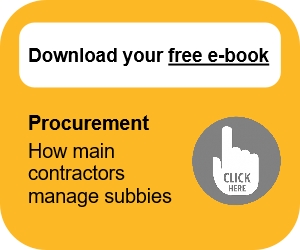Supplier selection
Contents |
[edit] Introduction
In the construction industry, ‘supplier’ is a very general term which refers to organisations contracted as part of the delivery of a built asset.
Critical steps in the supplier evaluation and selection process are:
- Recognising the need for a supplier.
- Determining the criteria for supplier selection.
- Identifying potential suppliers.
- Shortlisting suppliers.
- Evaluating and selecting the supplier.
- Contracting the selected supplier.
[edit] The need for a supplier
Suppliers might be need for a wide range of purposes, including:
- Consultancy services such as design and project management.
- Enabling and demolition works.
- The main construction contract works.
- Specialist sub-contract works.
- The supply of plant.
- The supply of products and materials.
- Maintenance and operation services.
Potential suppliers might be identified by research, advertising, recommendation, open competition (with or without design), selective competition (with or without design), or through an existing relationship such as a framework agreement.
[edit] Selection criteria
Some of the most common criteria that are used to select suppliers are set out below:
- Process and design capabilities: The supplier should have relevant previous experience, and should have the capability to supply as required.
- Quality: The product/service should be of a sufficient quality or meet the required specification.
- Cost: Total supplier costs should be assessed, including the product/service cost, ordering cost, logistics costs, lifecycle costs, delivery charges, and so on.
- Service: The ability of the supplier to provide an appropriate level of service, such as technical support post-purchase. What value added does the supplier offer?
- Capacity: The ability of the supplier to meet the requirements in accordance with the required delivery schedule.
- Location: The geographical location of a supplier may affect the delivery lead-time, transport and logistics costs, availability of support and so on.
- Management capability: The supplier’s track record on continuous improvement of their processes and standards, and their ability to maintain good relationships with their clients.
- Financial stability: Will they continue to be a reliable source of supply or are a risk to the project?
- Ordering system: The robustness and sophistication of the ordering system can impact on supply chain performance, and should be as easy and efficient as possible, with short delivery lead times.
- Compliance: Whether the supplier is fully compliant with environmental regulations, health and safety requirements, quality assurance standards and so on.
- Longer-term relationship: Whether they have the potential of being a long-term partner, with a willingness to share technologies and information in a mutually beneficial manner.
- Innovation: Is the supplier able to offer innovative products or services that would bring added value to the project?
- Proposed methodology: This might include mobilisation plans, design proposals, and non-compliant proposals if these have been allowed.
See also: Tender evaluation
[edit] Selection methods
Some of the methods that can be used as a means of determining how a supplier fits the criteria listed above include the following:
- Pre qualification questionnaire.
- Obtaining financial information, such as a publically-available report.
- Providing specifications and requesting a formal quote from the supplier.
- Pre-tender and mid tender interviews.
- Arranging a meeting or visit to the supplier.
- On-site assessment.
- Request for certificates to confirm capability.
- Feedback from other clients.
- Assessing industry databases or reviews.
- Evaluation of samples.
For more information see: Tender process and tender evaluation.
[edit] Related articles on Designing Buildings Wiki
Featured articles and news
A five minute introduction.
50th Golden anniversary ECA Edmundson apprentice award
Showcasing the very best electrotechnical and engineering services for half a century.
Welsh government consults on HRBs and reg changes
Seeking feedback on a new regulatory regime and a broad range of issues.
CIOB Client Guide (2nd edition) March 2025
Free download covering statutory dutyholder roles under the Building Safety Act and much more.
AI and automation in 3D modelling and spatial design
Can almost half of design development tasks be automated?
Minister quizzed, as responsibility transfers to MHCLG and BSR publishes new building control guidance.
UK environmental regulations reform 2025
Amid wider new approaches to ensure regulators and regulation support growth.
The maintenance challenge of tenements.
BSRIA Statutory Compliance Inspection Checklist
BG80/2025 now significantly updated to include requirements related to important changes in legislation.
Shortlist for the 2025 Roofscape Design Awards
Talent and innovation showcase announcement from the trussed rafter industry.
OpenUSD possibilities: Look before you leap
Being ready for the OpenUSD solutions set to transform architecture and design.
Global Asbestos Awareness Week 2025
Highlighting the continuing threat to trades persons.
Retrofit of Buildings, a CIOB Technical Publication
Now available in Arabic and Chinese aswell as English.
The context, schemes, standards, roles and relevance of the Building Safety Act.
Retrofit 25 – What's Stopping Us?
Exhibition Opens at The Building Centre.
Types of work to existing buildings
A simple circular economy wiki breakdown with further links.
A threat to the creativity that makes London special.
























